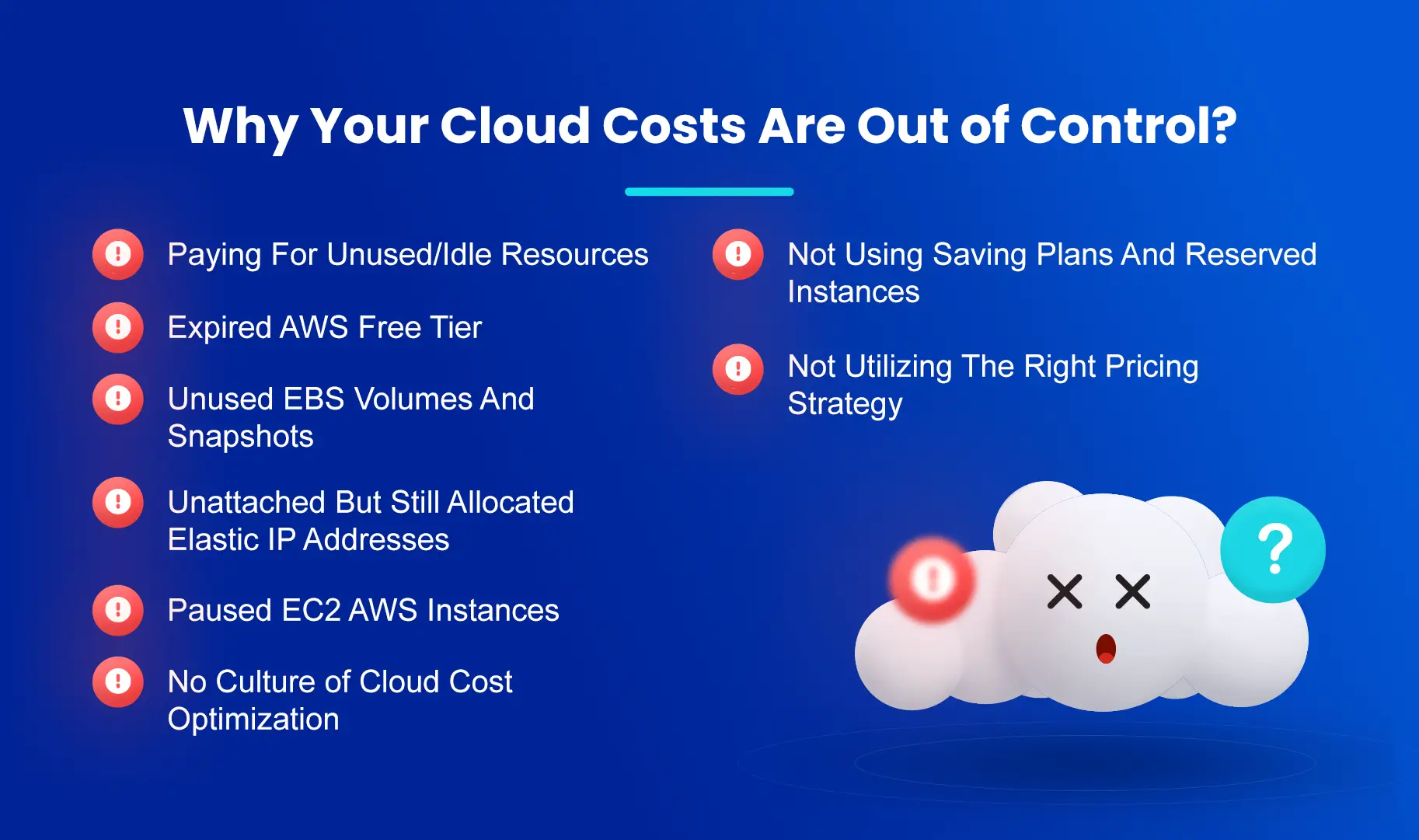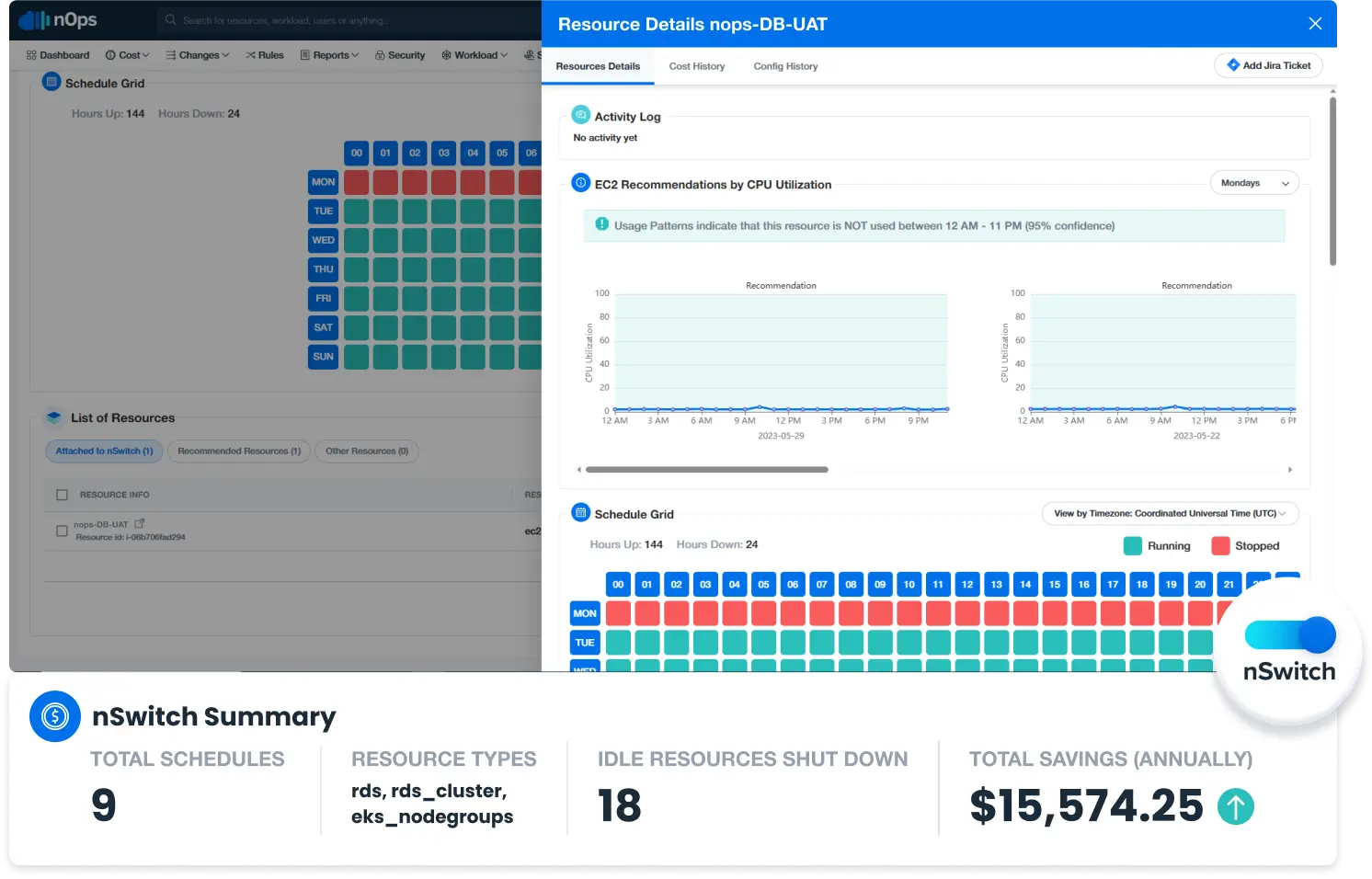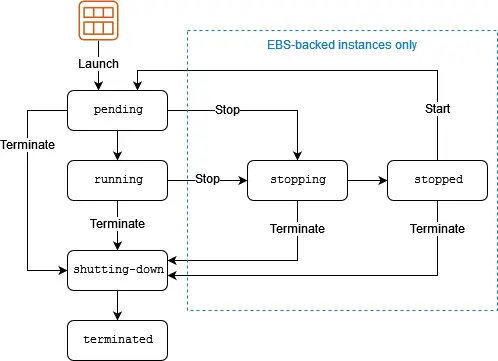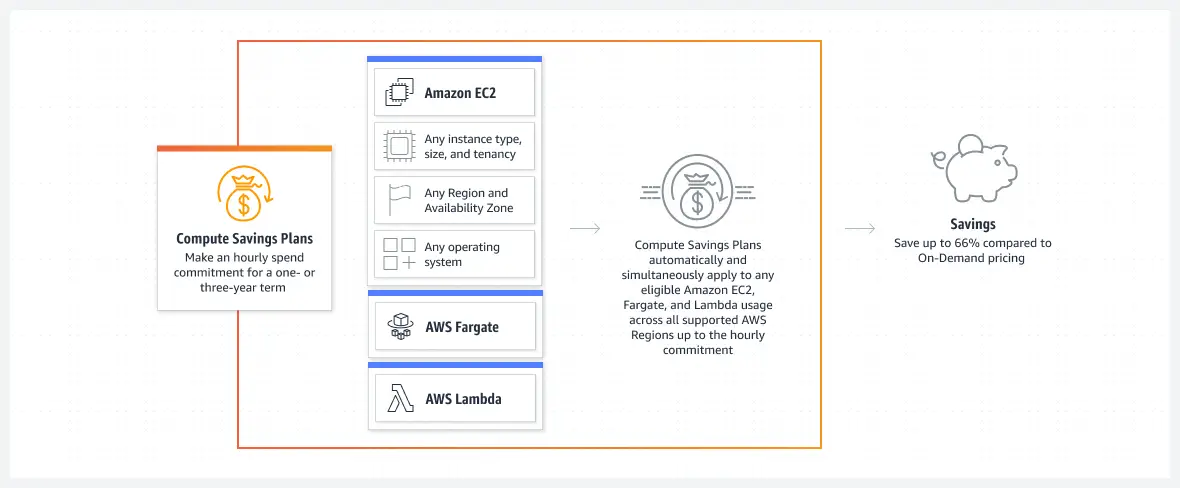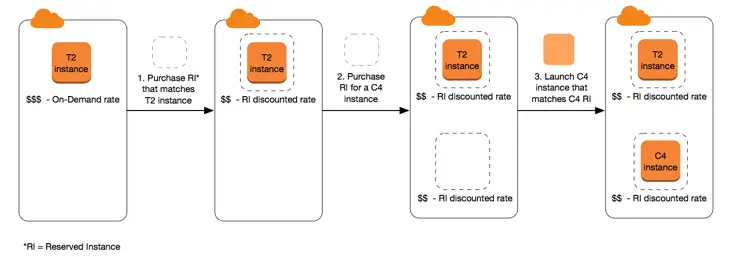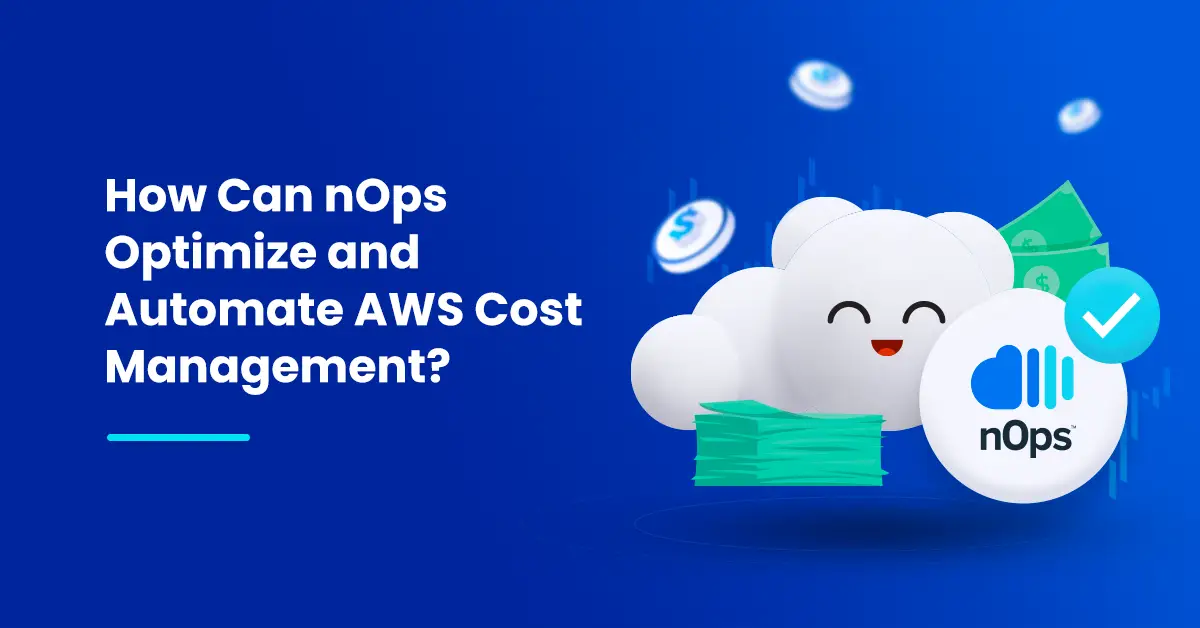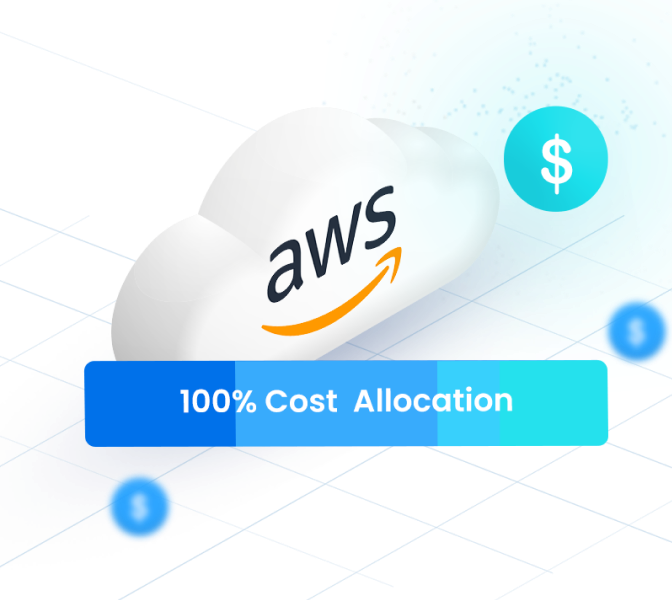- Blog
- Cost Allocation & Reporting
- 8 Reasons Why Your Cloud Costs Are Out of Control
8 Reasons Why Your Cloud Costs Are Out of Control
Last Updated: May 2, 2024, Cost Allocation & Reporting
According to a Gartner report, over 70 percent of cloud costs get wasted.Another research found that over 82% of cloud and IT decision-makers encounter unnecessary cloud costs.
There is no denying that the AWS pricing model is complex. Without effective monitoring and budgeting, it’s very easy for cloud costs to get out of control.
In this article, we discuss the top reasons why your cloud costs are out of control–and how to keep the cloud costs in check.
1. Paying For Unused/Idle Resources
When you have multiple teams and departments in your organization utilizing hundreds or thousands of AWS resources, it’s very easy to overlook idle resources that are currently provisioned but not being actively utilized. This can include several types of resources, including storage volumes, databases, virtual machines, and load balancers.
Unused or idle resources in AWS consume unnecessary computing power, and they can also drive up your cloud costs and reduce overall efficiency. That is why it’s important to regularly monitor, optimize, and reallocate idle resources to ensure you are only paying for the resources that you need.
nOps is a fully automated AWS cloud cost management platform that leverages AI and machine learning to understand your cloud usage pattern. It identifies idle resources and stops them automatically to help you save on cloud costs. The platform also looks for resource scheduling opportunities without spending too many valuable resources or time.
2. Expired AWS Free Tier
AWS offers a Free Tier that includes some short-term free trial offers for particular services and free services for 12 months after your AWS account sign-up. The Free Tier cannot be extended, and AWS will automatically bill you for these services based on the standard rates once it expires.
That is why looking into the resources you no longer need is important, and terminating them before the Free Tier expiration date. Most of the time, AWS sends a notification for the impending Free Tier expiry, but there is also the possibility of the notification getting missed. As a result, it’s a good practice to create a reminder and turn off resources before the trial period ends.
3. Unused EBS Volumes And Snapshots
Elastic Block Storage or EBS is a data storage solution in AWS. These EBS volumes are attached to EC2 instances.
But the lifecycle of EBS volumes is independent of EC2 instances. That means when an EC2 instance is terminated, the EBS volume attached to it does not directly get terminated. The EBS volumes remain active, and they can drive up your AWS bill unless you manually terminate them.
That is why it is important to monitor and shut down unattached EBS volumes before they drive up cloud costs. To delete EBS volumes, go to the Volumes pane inside the Amazon EC2 console, and select Action → Delete.
It’s important to note that deleting an EBS volume does not automatically delete snapshots associated with the volume. In case there are any snapshots of Amazon EBS volumes that aren’t required anymore, you should delete them as well.
4. Unattached But Still Allocated Elastic IP Addresses
An elastic IP is essentially a static IP address for your AWS account. But when you terminate an instance, the elastic IP addresses attached to it are not terminated on their own. They still remain allocated to you.
To manually terminate Elastic IP addresses, you need to open the Amazon EC2 console, go to the navigation pane and select Elastic IPs.
Select the IP address that should be removed, and choose Actions → Release Elastic IP addresses
5. Paused EC2 AWS Instances
Amazon EC2 instances form the very foundation of many AWS services. You can find all the instances listed in the Amazon EC2 console and check which instances have been started by which services.
While you have the option to start, stop or pause EC2 instances that you aren’t using, you might still get charged for their storage (EBS volumes). An instance gets deleted permanently only when it is terminated.
Source: AWS
6. No Culture of Cloud Cost Optimization
Cloud cost optimization isn’t just about pausing unused resources or finding the most effective Reserved Instances. It’s about creating a culture of resource usage and financial transparency across the organization.
After all, cloud cost optimization is a team effort. The only way to get high cloud costs under control is by making sure that all the stakeholders involved understand the reasoning behind cloud cost optimization.
This can be achieved by creating documentation about your AWS best practices, holding regular webinars/ meetings about cloud cost optimization, and implementing a company-wide tagging policy.
AWS Cloud Cost Allocation: The Complete Guide
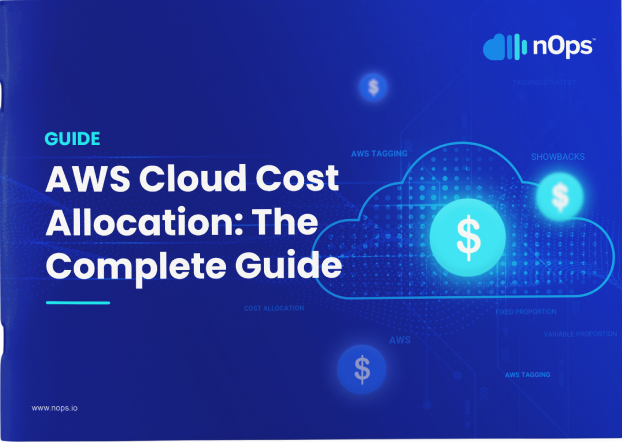
7. Not Using Saving Plans And Reserved Instances
Saving Plans and Reserved Instances are both great ways to save up on AWS costs without sacrificing resource capacity or overall performance.
When you buy AWS Savings Plans, you get wide savings on on-demand instances. But at the same time, you are required to commit to a minimum amount of computing power. The prices for Savings Plans are usually measured in dollars per year over the course of one or three years. There are three types of Saving Plans available: Compute Savings Plans, EC2 Instance Savings Plans, and Queued Savings Plans.
Source: AWS
With AWS Reserved Instances, you can save up to 72% on on-demand instances when purchasing them in advance for a period of one or three years. In other words, you book a fixed amount of computing power and pay for it in advance. There are two types of RIs available: Convertible RIs and Standard RIs.
Source: AWS
It’s important to note that they are both complementary to each other and not substitutes. You don’t need to choose only one of the two. It’s also possible to incorporate both as part of your cloud strategy. The goal should always be to utilize each to their potential.
8. Not Utilizing The Right Pricing Strategy
What works for one company may not work for you. The right AWS pricing strategy for your organization will depend on your business needs, current cloud budget, and future cloud goals.
One of the most significant benefits of cloud services is that it allows you to optimize cloud costs in a way that matches your business needs–even if your needs end up changing over time. With the different pricing models available on AWS, it becomes possible to customize pricing plans easily so that you can improve business agility, reduce overall complexity, and focus on innovation.
How Can nOps Optimize and Automate AWS Cost Management?
nOps is an automated AWS cloud management platform that can help reduce your AWS bill by over 50% on auto-pilot.
While your team focuses on innovation, nOps runs in the background to track, analyze, and optimize your AWS costs. With features like automated cost allocation tagging, cost history and audit trail reports, smarter planning for spot instances, automated scheduling for EC2 instances, and more, nOps can help bring down your cloud costs significantly.
nOps runs optimization on auto-pilot and helps you with the following:
- Paying less for what you use
- Pausing idle resources automatically.
Let us help you save! Sign up for nOps today.



